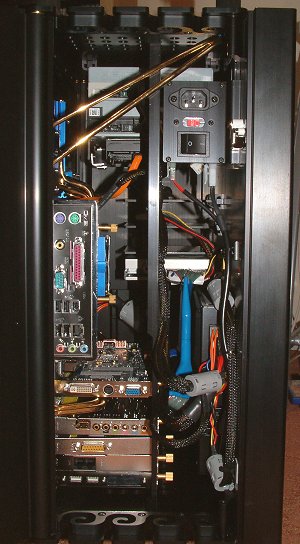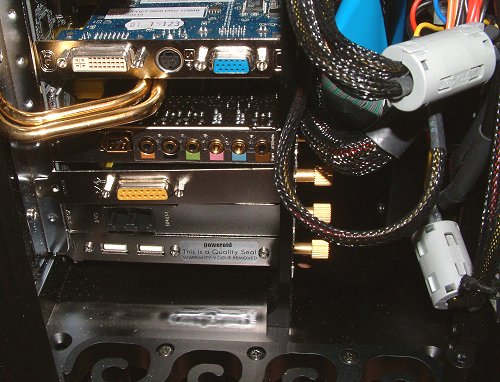The back

The back's generally similar to the front. The component and heatpipe arrangement looks like a mad professor's work in progress. Users must remember that passive cooling ability is the number one criteria here. Design elegance comes way down the list, unfortunately. The confined nature also shows just how difficult it is to change components over at the back.
Where Zalman's done especially well is in specifying a passively-cooled PSU that's capable of powering a powerful rig. Some of the more notable inclusions in our sample were an AMD Athlon 64 Model 3200+ CPU, 128MB Radeon 9800 Pro graphics card, 1GB of Corsair Select memory, a 250GB Maxtor SATA hard drive, and an Audigy2 ZS. That's quite a combined toll, so high-quality PSUs are a must.

A closer look the bottom section shows a couple of heatpipes feeding off the graphics card and terminating at a block attached to the case. We've already seen a couple at the front. The same is true for the CPU, as another couple feed off to the side and then angle up, past the PSU, to the other side. The premise is to equally distribute heatpipe-created heat across both sides of the chassis. Also note the 4 notches at the bottom, replicated at the front. This allows one to close the door and keep cabling tidy.
Zalman's gone to painstaking lengths to ensure uber-quiet operation. So other components whos noise profile is usually masked by cooling then sound louder than normal. Take, for example, the Maxtor 250GB SATA (Y250M0) hard drive. It's a quiet, efficient hard drive that features fluid bearings, yet it positively sounds like a screecher inside Zalman's ever-so-quiet PC, for there's little other noise to disguise the sound made by the heads seeking. This is most apparent when transferring data over partitions or installing new programs. Switching on the unit is an eerie affair. Nothing appears to happen until the hard drive in use. That's the first and last verification that it's all working. Optical drives, too, sound far louder and harsher than they would in a regular PC.
It's definitely strange until you've experienced it for yourself. If you've been using PCs for any considerable length of time you tend to filter out the base machine noise. It then becomes all too conspicuous by its absence. The system's not truly silent, but it would need a very acute ear right next to the chassis to pick up any meaningful noise.
Zalman's main aim here was to excel in an area that's not covered a great deal. A truly silent PC would eschew components with any moving parts and replace them with solid-state devices. This is as close as you'll get without spending a horrific amount of money. That's confirmation enough that Zalman has done an exemplary job with this odd-looking PC.









